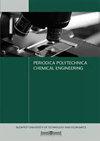CFD Investigation of Dry Tray Pressure Drop of Perforated Trays without Downcomer
IF 1.8
4区 工程技术
Q3 ENGINEERING, CHEMICAL
引用次数: 0
Abstract
The dry tray pressure drop behaviors in trays without downcomer with different inclination of holes (standard, 75°, 60° and 45°) and tray thickness (2.5, 5, and 10 mm) are investigated. The trays are investigated using computational fluid dynamics (CFD) in Ansys Fluent® software. 20 °C air was used to represent the gas phase with 20–50 m3/h flow rates. The column there are four trays with 7 mm of hole diameter.The CFD results determined that the higher angle of the holes with respect to the tray causes smaller dry tray pressure drop and turbulence intensity in the gas flow. Furthermore, in 75° hole inclined perforated tray and the standard hole the dry tray pressure drop is similar. From the simulation results it is also determined that in case of higher tray thickness the dry tray pressure drop is lower.On the basis of the CFD simulation results some correlations can be determined for the calculation of the dry tray pressure drop of the different trays.无降管穿孔塔板干式塔板压降的CFD研究
研究了不同孔倾角(标准、75°、60°和45°)和不同板厚(2.5、5和10 mm)条件下,无降水塔板的压降特性。利用Ansys Fluent®软件中的计算流体动力学(CFD)对托盘进行了研究。用20℃空气代表气相,流速为20 - 50 m3/h。塔内有4个孔直径为7mm的托盘。CFD计算结果表明,孔相对于塔板的角度越大,干塔板压降越小,气流中的湍流强度越小。此外,在75°孔斜穿孔塔板和标准孔中,干塔板压降相似。仿真结果还表明,当塔板厚度较大时,干塔板压降较小。在CFD模拟结果的基础上,可以确定不同塔板的干塔板压降计算的一些相关性。
本文章由计算机程序翻译,如有差异,请以英文原文为准。
求助全文
约1分钟内获得全文
求助全文
来源期刊

Periodica Polytechnica Chemical Engineering
ENGINEERING, CHEMICAL-
CiteScore
3.10
自引率
7.70%
发文量
44
审稿时长
>12 weeks
期刊介绍:
The main scope of the journal is to publish original research articles in the wide field of chemical engineering including environmental and bioengineering.
 求助内容:
求助内容: 应助结果提醒方式:
应助结果提醒方式:


